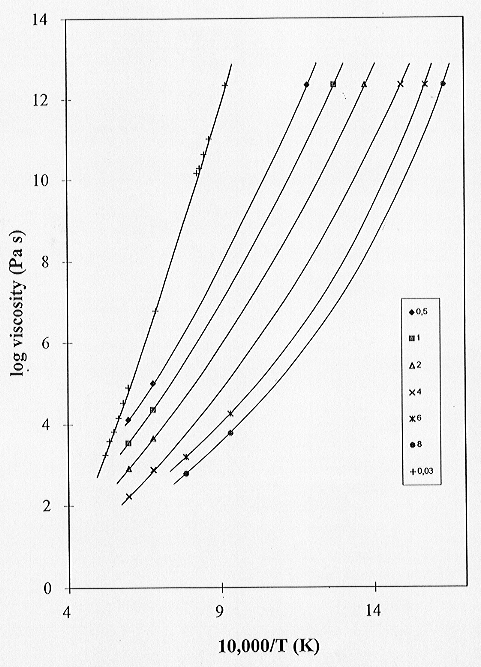

Recent investigations of both the high and low temperature viscosities of hydrous haplogranitic melts allow, for the first time, estimates of the degree of non-Arrhenian behaviour of water-rich silicic magmas to be made.
The effect of pressure on the viscosity of hydrous melts has been estimated to be very small by several workers. This is consistent with the notion that the viscosities of moderately depolymerized anhydrous silicate melts are also relatively insensitive to pressure under crustal conditions. Additional evidence for the minor role of pressure in influencing viscosity comes from differential thermal analysis of melts from which a very minor pressure dependence of the glass from which a transition temperature has been obtained up to 7 kbar. Thus comparison of the influence of water on the viscosities and glass transition temperatures of haplogranitic melts at pressures between 1 atm and 10 kbar is permissible. In fact, the agreement observed in the present comparison significantly strengthens the assumptions and arguments made here concerning the minor role of pressure in controlling the glass transition temperature.
The glass transition temperatures for melts of haplogranite HPG8 containing 0.5, 1,2,4,6 and 8 wt% added water corresponding to the 12.38 (log10) Pa s isokom are compared with the parametrization of high-temperature, low-viscosity data presented recently in Fig. 3.7-3 for AOQ (similar to HPG8) melt with the same water contents. A clear trend of decreasing viscosity with increasing water content is seen. Additionally, a clear trend of increasingly non-Arrhenian behaviour, or increasing fragility with increasing water content can be observed from Fig. 3.7-3.
The estimation of the viscosity-temperature relationships of hydrous granitic melts presented here have implications for the behaviour of granitic magmas and rhyolitic lavas in nature. Water-rich granitic systems intruded at intermediate levels within the Earth´s crust under water-saturated or slightly-water-undersaturated conditions can contain up to several weight percent water dissolved in the liquid phase. Figure 3.7-3 of the present study illustrates that the estimation of viscosities of melts containing 4-8 wt% water under temperatures relevant to their crystallization range during midcrustal intrusion (500° - 700 °C) are somewhat higher than those that would be estimated using the Arrhenian assumption (the discrepancy is 1 log unit at 500 °C). Given the uncertainties in the estimation of temperature, melt composition and other extensive and intensive parameters present during the crystallization of plutons and their apophyses this uncertainty may be tolerable.
The estimation of the glass transition temperature and viscosity of
hydrous calcalkaline rhyolites during their subvolcanic ascent, degassing,
and eruption is more drastically affected by the degree of non-Arrhenian
behaviour exhibited here. Water contents of up to 2 wt% are thought to
be involved in the late stages of erupting degassing rhyolitic magmatic
systems during explosive events. Fig. 3.7-3 indicates that the estimation
of the viscosities using Arrhenian extrapolation from high temperature
viscosity data may be in error by up to 3 log units of viscosity for the
temperatures relevant to these processes. The corollary of this is that
the glass transition temperature itself will be overestimated for that
same melt composition by a much as 150 °C. The lower glass transition
temperatures derived from Arrhenian extrapolations of the high temperature
viscosity data will thus be in serious error and hamper accordingly the
interpretation of the role of the glass transition in influencing the eruption
dynamics and thermodynamic response of cooling magma during explosive and
effusive volcanic activity.
 |
Figure 3.7-3: Comparison of the viscosity-temperature data from the fit to the data of Fig. 3.8-9 with viscosity-temperature data from the parameterization of high temperature viscosity data. This comparison defines non-Arrhenian viscosity-temperature relationships for hydrous granitic melts from 0.5 to 8.0 wt% H2O. Sources of data: see Dingwell (1996, PEPI, in press). |

Tel: +49-(0) 921 55 3700 / 3766, Fax: +49-(0) 921 55 3769, E-mail: bayerisches.geoinstitut(at)uni-bayreuth.de
 Previous page
Previous page